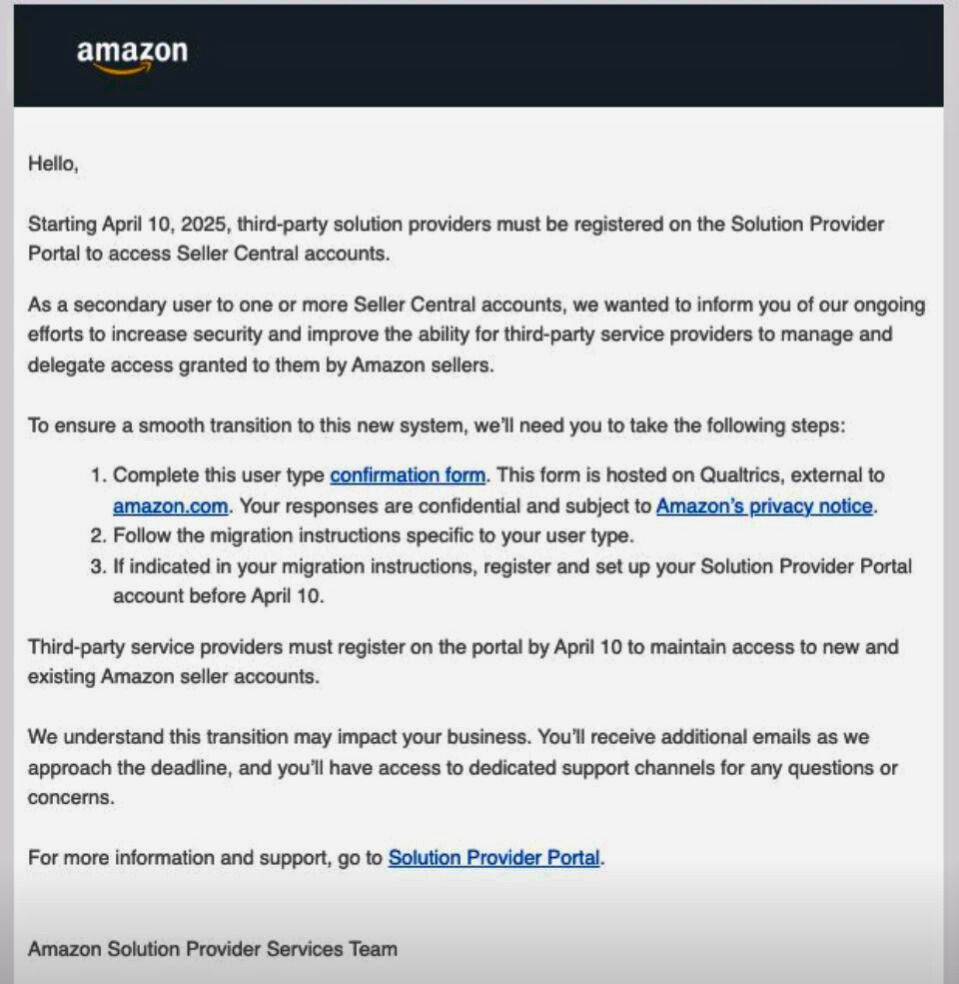
The Amazon Solution Provider Portal will be the new platform for third-party developers and service providers to manage their business, replacing Seller Central and Vendor Central by August 31, 2025.
Amazon sellers rely on various tools and agencies to manage their accounts. Now, these services face a major hurdle. Many service providers will find themselves locked out if they don’t comply with Amazon’s new system.
Amazon has made a big announcement that is shaking up the world of third-party service providers. Starting April 10, 2025, agencies, consultants, and software providers will be required to register and use Amazon’s Solution Provider Portal (SPP) to access Seller Central.
This major update is forcing businesses that rely on external tools and services to adapt or risk losing access to critical features. Here’s what you need to know about the changes and how they will impact both service providers and Amazon sellers.
Why the Amazon Solution Provider Portal Matters to Sellers, Agencies, and Service Providers
A recent article on Amazon’s Selling Partner API discussed the mandated migration of third-party service providers to the Solution Provider Portal.
In her LinkedIn post, the CEO of Online Seller Solutions, Vanessa Hung, urged her fellow service providers to check the announcement, noting that it was also sent to the account linked to a secondary user in Seller Central.

With SPP set to replace Seller Central and Vendor Central platforms by August 31, 2025, agencies, developers, and service providers must adapt to continue supporting Amazon sellers.
What is the Solution Provider Portal?
The SPP acts as a central hub, streamlining how developers and service providers build and manage solutions for Amazon partners. It consolidates developer accounts, applications, and profiles, simplifying administrative tasks.
This platform replaces Seller Central and Vendor Central for these groups, becoming the sole gateway for managing Selling Partner API (SP-API) integrations. The SPP also consolidates service provider registration, onboarding, and service listing, which were handled previously by Service Provider Central (SP Central).
Which stakeholders will be affected?
According to Amazon, the recent update will impact third-party SP-API developers and service providers, including sellers, vendors, supply chain partners, and business buyers. This policy is in effect across all Amazon platforms.
James Northcott"SPP is here, and like it or not, it’s happening."
What actions should stakeholders take?
According to Amazon, affected stakeholders must take specific actions to comply with the new Solution Provider Portal (SPP).
Existing SP-API developers will find a guided migration workflow upon logging into Seller Central’s “Develop Apps” section or Vendor Central’s “API Integrations.” This allows for the consolidation of multiple SP-API profiles.
New SP-API developers will register directly on the SPP to manage integrations and access development tools. Existing service providers, currently registered with Service Provider Central, will be migrated through direct communication from Amazon, with no immediate impact to current accounts.
New service providers will register directly through the SPP. All users are advised to review the Amazon Services Business Solutions Agreement.
User Permissions in the Solution Provider Portal
Key User Permission Guidelines
- For Sellers
Seller Central administrators must add external contractors and third-party service providers as authorized partners, not as secondary users, to ensure proper access management.
- For Service Providers
Administrators can assign specific roles based on employee responsibilities, ensuring secure and efficient task delegation. Permissions can be monitored, adjusted, or revoked as needed to maintain compliance with Amazon’s security protocols.
SPP User Permissions Include:
- Role-based access to service categories (View, Edit, View & Edit, Admin).
- Controlled access to seller data based on service provider roles.
- Authorization to perform specific account-related activities.
The company voluntarily paused MK30 operations after identifying potential issues with its altitude sensors in high-dust environments, a precautionary measure to ensure reliability. This decision follows over 5,000 test flights and 1,300 flight hours, where engineers deliberately pushed the drone to its operational limits.
Testing included simulating hardware failures, forcing software switchovers, and even flying helicopters at the drones to assess obstacle avoidance. Amazon’s approach borrows from commercial aviation and self-driving car safety protocols, setting higher benchmarks than required by regulators.
The company remains confident in the MK30’s capabilities and plans to resume deliveries once enhancements are complete, reaffirming its commitment to advancing autonomous aerial logistics.
Agencies Face Hurdles with Amazon SPP
The Amazon SPP migration has introduced a series of obstacles for agencies and stakeholders, demanding careful planning and execution.
Difficult Account Migration
Sam Hager, Co-founder of MixShift, highlighted a key challenge in his LinkedIn post, calling for Amazon to introduce a Manager Account for developers and agencies. He noted that such a feature would allow authentication of multiple sellers and vendors at once, rather than requiring individual authentication for each region.
Our Amazon Agency founder, Steven Pope, also shared the same problem and commented on his LinkedIn post that he is not looking forward to transitioning thousands of accounts.
Rebranding Required to Get SPP Approval
Amazon’s latest mandate raised concerns for agencies with “Amazon” in their business names. Steven also highlighted this challenge in a recent LinkedIn post, questioning whether his agency—and hundreds of others—will have to rebrand to comply.
Amazon has historically denied access to businesses with “Amazon” in their name, even if they were established before Amazon obtained its trademark. Similar restrictions apply to company names containing “Prime” or “AMZ.”
With Amazon now enforcing SPP as the only access route for third-party service providers, agencies that have operated for years under these names face uncertainty about their eligibility—and potentially, their entire business model.
As Steven pointed out, one potential solution is rebranding our agency to comply with Amazon’s requirements.
Amazon Solution Provider Portal FAQs
Here are some of the SPP questions that Amazon has addressed.
Can I still use my original Seller Central account after migration?
Does an SPP account provide access to all Amazon stores?
Are there new features coming to SPP?
Yes, Amazon is introducing several enhancements to improve the user experience:
- Customizable Notifications: Solution providers can select preferred communication methods and designated contacts for different types of Amazon updates.
- Self-Service Listing: Service providers can quickly submit their services to be featured on the Service Provider Network, improving visibility and accessibility.
- Simplified Authorization: Selling partners can easily approve SPN-listed service providers with a single click on the service listing page.






